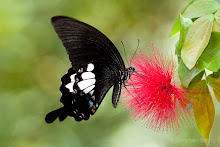now so I should be updating my blog more often. :) Today
I have a write up on the butterflies of the Tampines Eco Green.
It is a eco- friendly park, with secondary forest, grass and
shrub land, and freshwater habitats. It boasts over 15 species
of dragonflies, 70 birds and many butterflies! At the entrance,
many pea plants have been planted. The peas attract many danainae
( tigers and crows ) butterflies. They like to feed on the dried seed
pods. Below is a dark glassy tiger.

The pea plants are also the caterpillar host plants of the
pea blue. The pea blues are very common in the park and often flutter
close to the ground.

At the park you can also find the two silverline species there.
The hostplant, the acacia auriculiformis, grows abundantly
around the grasslands. Both of them are rapid fliers. This is a
club silverline.

This one is a long banded silverline.

The leea rubra plants that grow along the edge of the lake

This one is a long banded silverline.

The leea rubra plants that grow along the edge of the lake
have attracted many species of butterflies to visit too. Look
out for the glassy tigers, plain and common tigers, common mime,
grass yellows and other surprise visitors! This conjoined swift
is taking a sip from one of the small flowers.



And here is a palm dart resting on the flower buds.

You can also see tawny costers at the grassland areas.

You can also see tawny costers at the grassland areas.
They flutter slowly in the wind and are a joy to watch.
Their host plant, a passionflower called passiflora foedita
grows in the wooded spots.

There are so many more butterflies to see at the Tampines
Eco Green and on a sunny day at least 15 species can be spotted.
The park has an area of 36.5 hectares and is wedged between the
Sungei Tampines Canal, the Tampines Expressway and the
Tampines ave 12. There are plenty of ways to get there but there
is no car park.
It is definitely worth a visit



























